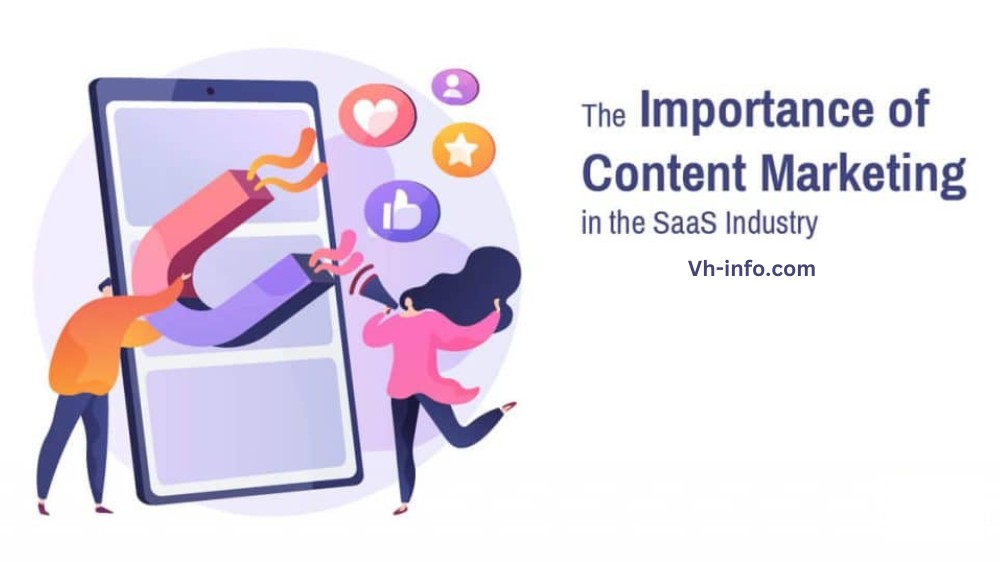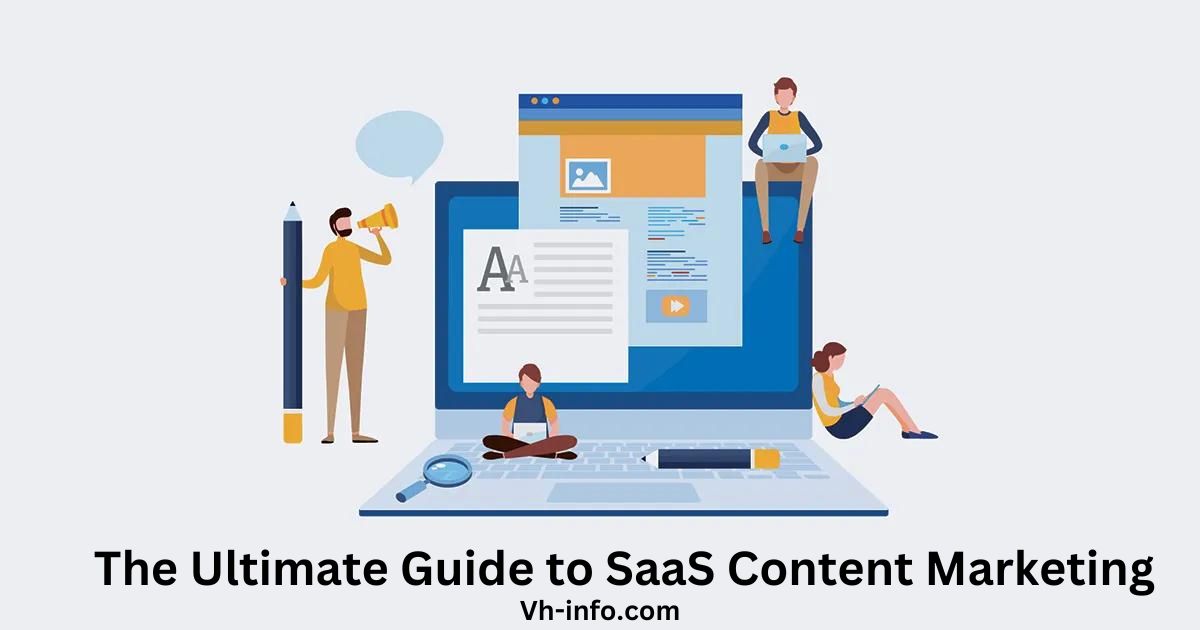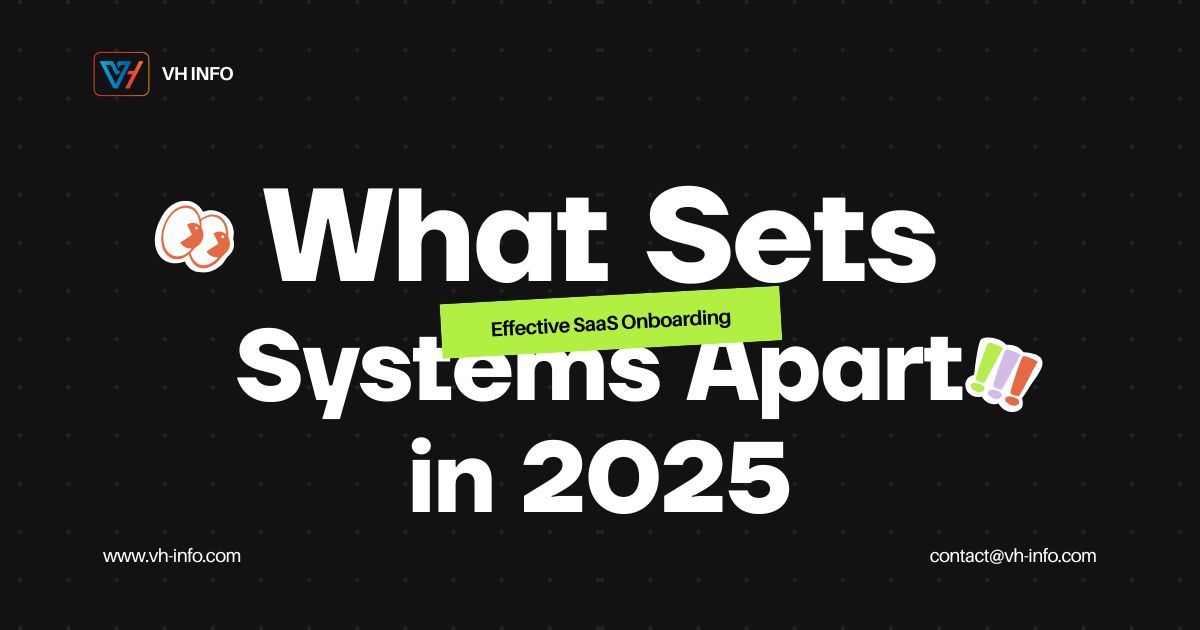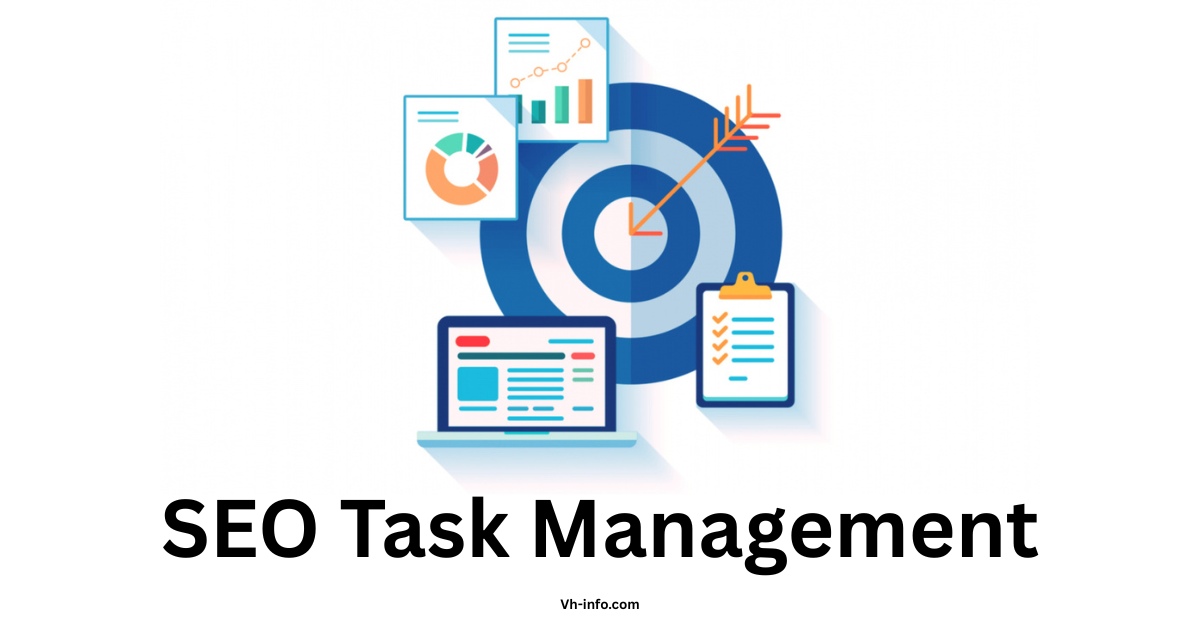Are you a SaaS business owner or marketer aiming to enhance your content marketing efforts? Great news!
We’ve crafted the ultimate guide to SaaS content marketing just for you.
In this blog, we’ll delve into what SaaS content marketing involves and why it’s essential for your business. You’ll discover its advantages compared to traditional marketing approaches.
Plus, we’ll share successful examples and expert tips to help you create your own effective strategy.
We’ll even address common questions about SaaS content marketing’s impact on customer journeys and suggest top-notch tools for organizing your strategy. Don’t miss out on this comprehensive guide to elevate your SaaS business with powerful content marketing!
If you’re interested in link-building strategies specifically tailored for SaaS companies, VH-Info, a reputable agency in this field, can provide valuable assistance and expertise to further enhance your content marketing initiatives.
What Is SaaS Content Marketing?

SaaS content marketing refers to creating and sharing valuable content to attract and retain users for your software-as-a-service (SaaS) product. It involves publishing blogs, ebooks, videos, and other type of content that educates your target audience on using your SaaS platform to solve their problems. The ultimate goal is to position your micro SaaS as an authority in your space and encourage sign-ups, retention, and effective content distribution for content marketers.
Why Is SaaS Content Marketing Important?

SaaS content marketing is important for several key reasons:
- Attracts qualified leads. High-quality, valuable content demonstrates your SaaS company’s expertise and helps attract leads that are more likely to convert to paying customers. Useful content earns trust and establishes credibility.
- Drives traffic and conversions. Well-executed content marketing increases website traffic, which provides more opportunities to convert visitors into leads and customers. Things like blogs, ebooks, and webinars give people content they find useful and want to share or link to from other sites.
- Enhances SEO and discoverability. Search engines like unique, fresh content. An ongoing stream of blogs, articles, and other content assets makes it more likely your pages will be indexed and ranked well in search engines. This improves visibility and makes it easier for ideal potential buyers to find your SaaS.
- Educates the buyer’s journey. From awareness to consideration to decision, good content offers education tailored to each phase of the buyer’s journey. Early on it establishes thought leadership and later helps guide buyers to choosing your SaaS and seeing the value it provides. Good content for a GCSE English tutor aligns with the buyer’s journey, guiding students from awareness to decision and showcasing the value of the tutoring service.
- Builds customer retention and loyalty. Existing customers also need ongoing education and communication. A content strategy provides this while demonstrating commitment to the industries and use cases you serve. This strengthens retention and loyalty.
Why Is Content Marketing for SaaS Companies Different?
SaaS content marketing is different from content marketing for non-SaaS companies in a few key ways:
- Highly educational focus – SaaS buyers need more education during the evaluation process as they are often buying something technical, intricate, and cannot hold in their hands. So SaaS content must walk through product functionality, integration needs, use cases, etc.
- Explaining value over time – The SaaS subscription model is paid for on an ongoing basis, so content must justify ongoing spend and long-term return on investment. This means demonstrating not just immediate value but continually evolving value.
- Comparing complex products – SaaS buyers tend to do more product research and compare complex products more rigorously before committing. So SaaS content frequently needs to differentiate against alternatives and directly compare product capabilities.
- Guide configuration/setup – Because SaaS solutions can often be complex to implement, content frequently is needed to guide customers on configuration, data migration, integration with other systems, and getting users rolled out successfully.
- High adoption focus – Since SaaS solutions rely on ongoing renewals for revenue, there is a heavy focus in content on driving user adoption, training, and guiding customers to get maximal value from the platform.
Benefits of SaaS Content Marketing
Here are some of the key benefits of SaaS content marketing:
- Lead generation – Content like blog posts, eBooks, and whitepapers, especially when sourced through a content marketplace, allow you to demonstrate expertise and value to potential customers. This helps convert website visitors into leads.
- Lower customer acquisition costs – Quality content attracts and converts leads more cost-effectively than relying solely on paid ads or a sales team. The content does some of the heavy lifting.
- Brand building – Consistent, useful content allows you to build awareness and trust in your SaaS product and company. You establish thought leadership in your niche.
- SEO value – Search engines reward websites with fresh, updated content. This content can help improve rankings and organic traffic to your site over time.
- Customer retention – Existing customers benefit from continued education through your various content assets. This strengthens the relationship and improves customer lifetime value.
- Upsells/expansion revenue – Good content helps customers continually see the value in your SaaS, making them more likely to upgrade plans or add on additional capabilities as they’re released.
- Competitive differentiation – Your educational content and messaging sets you apart from competitors and demonstrates why customers should choose your solution over alternatives.
Why is content marketing important for SaaS companies?
Content marketing is crucial for SaaS companies for a few key reasons:
- Lead generation and nurturing – The SaaS buying process often has a long sales cycle and requires building awareness and trust before a purchase. Ongoing useful content that offers value helps capture, nurture, and qualify leads over time.
- Product education – SaaS products tend to be relatively complex or technical compared to some other offerings. Quality content helps educate prospective customers on how the product works, what problems it addresses, proper configuration, use cases, integration requirements etc. This level of education is usually required before a SaaS purchase.
- Driving adoption and renewals – Since SaaS relies on ongoing renewals for long-term revenue, content plays a big role in driving user adoption, helping customers gain increasing value from the product over time, and building loyalty – leading to retention and expansion revenue.
- SEO visibility – Content marketing gives SaaS companies an opportunity to strengthen SEO and organic visibility. This can be a key channel driving awareness and leads. Ranking well for relevant buyer keywords can pay dividends.
- Competitive differentiation – The right content strategy helps SaaS companies stand out from competitors by demonstrating deeper expertise around customer pain points and industry-specific use cases. Becoming a true thought leader via content is powerful.
Partnering with a link building agency such as VH-Info can make a big difference in how well a SaaS company’s content strategy works.
VH-Info helps by getting important links from trusted industry websites to the SaaS company’s top-notch content. This boosts the content’s ranking in search results and helps more people find it.
As a result, the SaaS company attracts more of the right customers to their helpful content, showing expertise and credibility in their field. Combining VH-Info’s services with content marketing can supercharge the benefits, making it even more impactful for SaaS brands.
How to distribute your SaaS content?

Making sure lots of people see your content is just as important as making the content itself. You should plan how to share your content even before making it.
There are three main ways to share content:
- Your own places: These are places that belong to you, like your podcast, blog, email list, and social media accounts. You can post whatever you want there because they’re yours!
- Other people’s places: These are places owned by others, like blogs, news sites, forums, and review sites. You can post things there for free, but you don’t own the content.
- Paying for places: These are places or people who will share your stuff for money. Sometimes, this can be really good for reaching lots of people, but it’s important to be careful about who you work with so you reach the right audience.
Remember, each place where you share stuff has its own rules and ways of doing things. This means you need to adjust your content to fit each place.
If you do it well, lots of people will see and like your content. But if you don’t think about what each place needs, your content might not get noticed. For instance, long articles won’t work well on Instagram or Twitter, but you can turn them into shorter, easier-to-read graphics. It’s really important to change your content to fit each place’s style and the people who use it, ensuring a great user experience.
How does content marketing help SaaS businesses?

Here’s a deeper look at how content marketing helps SaaS businesses in 3 key areas – brand, ROI, and customer connection – especially when combined with the services of a link building agency like VH-Info:
Increased Brand Awareness & Authority
Creating a steady stream of educational blogs, ebooks, webinars, and other content establishes a SaaS company as a thought leader in their space. It demonstrates deep understanding of customer pain points. Over time, this builds significant brand awareness and trust in the company’s expertise. However, partnering with VH-Info takes it a big step further by getting existing content placed on and linked from major industry media sites. This massively amplifies reach and cements perception as a top authority.
A Higher ROI Without a Massive Budget
Great content attracts and nurtures leads more cost-effectively than traditional sales and marketing methods alone. Then VH-Info maximizes ROI further through higher-converting organic traffic from SEO rankings and backlinks. The compounding effect is a higher volume of customers without linearly scaling budgets and teams. Execution with precision trumps excessive spend.
A Powerful Connection With Customers
Truly helpful, empathetic content builds an emotional connection and community around a SaaS brand. When customers feel their problems are understood and automated solutions carefully considered, it fosters loyalty. This effect becomes even more scalable when VH-Info pushes SaaS content out to broader, engaged industry audiences through securing backlinks. It grows connection beyond existing channels.
Best SaaS Content Marketing Examples

Here are some excellent examples of effective content marketing from leading SaaS companies:
- HubSpot – Produces a vast amount of marketing, sales, and service content like blogs, ebooks, courses, and videos. Their content strategy fuels their growth and they educate on implementing inbound marketing.
- Moz – Well known for data-driven content all about SEO, inbound marketing, and analytics. Moz shares optimization best practices and also uses content to position their software tools as go-to solutions.
- Drift – Leverages blogs, videos, podcasts and more on conversational marketing, sales, and business leadership. Their regular streaming and audio content has allowed them to rapidly become a thought leader.
- Mailchimp – Email marketing focused content helps attract their target SMB customers. Their blog and guides demonstrate expertise on optimizing campaigns while humanizing their brand.
- Slack – Slack uses their blog and social channels to produce bite-sized, engaging content that highlights use cases, tips, and learnings around improving workplace productivity and communication.
Each of these SaaS leaders produce regular, high-quality content that aligns closely with their product solutions and buyer needs.
This is where a link building agency like VH-Info can help take content performance to the next level. By pursuing strategic backlink placements from industry authority sites to this compelling SaaS content, VH-Info makes this content more visible in organic search.
Higher authority backlinks result in improved search rankings and increased qualified organic traffic – amplifying the lead generation and branding power of the content tenfold. VH-Info’s link building specialists essentially get these SaaS companies’ amazing content in front of a lot more of their target audience.
What makes a SaaS content marketing strategy successful?

Here are the key ingredients for a successful SaaS content marketing strategy, made even more impactful when combined with the services of a link building agency like VH-Info:
- Customer-centric – The content should focus squarely on target customer pain points, challenges, and the ways the SaaS solution helps address those specific issues. All content stems from a deep understanding of the ideal buyer.
- Educational over promotional – While some content will necessarily discuss product capabilities, the content should aim to truly teach, inform, entertain or inspire. Pure product pitches alone don’t build relationships.
- Thought leadership – Position subject matter experts and company leaders as trusted advisors that prospects can rely on. Demonstrate expertise around industry trends and customer needs.
- Varied formats – Leverage diverse content types like long-form guides, brief visual content, videos, podcasts, webcasts, one-pagers, blogs, and more. You can even work with a 2D animation studio to make your video content more engaging and dynamic. So, try to integrate different formats in your content marketing. Different formats appeal in different contexts.
- Promoted across channels – Make sure content gets visibility. Promote it via email nurturing streams, social media, paid ads, contributor networks, website banners, sales enablement tools and anywhere else it will reach customers.
- Aligned to buyer’s journey – Early stage content should build awareness, while later stage content helps guide detailed product evaluation and purchase decisions. Map content to each buyer stage.
- Results measured – Analytics should track content engagement across formats and stages of the funnel. Continually optimize based on performance data.
So, VH-Info supercharges a SaaS content marketing strategy by securing high quality backlink placements and dramatically improving search visibility – this compounds all the existing benefits of strategic, customer-focused content creation. The awareness building and lead generation scale massively.
A Step-by-Step Guide to Creating a Killer SaaS Content Marketing Strategy

Here is a step-by-step guide to creating a killer SaaS content marketing strategy:
- Identify Your Target Audience: Start by getting crystal clear on who your ideal customers are. Define their demographics, challenges, and goals. Create detailed buyer personas and user stories to help you really understand what your target audience is looking for. This will inform the types of content you create.
- Set Your Content Marketing Goals: Now determine what the goals of your content marketing program will be. Do you want to increase signups? Boost renewals or upsells? Reduce customer churn? Increase search engine traffic? Get more inbound links? Set specific, measurable goals that tie to your revenue objectives.
- Audit Your Existing Content: Take a close look at your existing content. Identify strengths and weaknesses. Look for areas to improve and opportunities to repurpose or promote additional content. Use Google Analytics and internal search data to see what content performs best. Something like a content audit is essential.
- Map Out Your Content By Buyer Journey Stage: Map out your content to the typical buyer journey from awareness to consideration to decision. Identify gaps in your content where prospects may likely seek information. Determine what types of content will resonate best at each stage and will help move prospects to the next stage.
- Develop Compelling Content Pillars & Topics: Determine your core content pillars and topics that align to your business goals and buyer needs. Consider trending topics, commonly asked questions, search volume and competitors. Leverage tools like BuzzSumo and AnswerThePublic to find gaps and opportunities. Develop document types like blogs, ebooks, guides around these topics.
- Create a Content Production Schedule: Plan your editorial calendar for the next 12 months. Choose key themes, topics and content types for each month or quarter. Maintain a healthy mix of new thought leadership and repurposed, evergreen content. Aim for a regular cadence, at least 4x new content per month.
- Promote and Repurpose Your Content: Amplify your content reach by promoting it across your website, email, social media, and more. Repurpose your content by turning a blog post into a video, podcast, or infographic. For instance, you can use tools like AI text to video to easily transform written content into engaging videos. Additionally, continue optimizing and updating evergreen content to boost its lifespan and effectiveness.
- Analyze and Refine Your Efforts: Use Google Analytics, social media statistics, subscriber growth, and sales data to determine your most effective pieces of content. See what converts and engages your audience best. Keep experimenting with new content formats and ideas informed by the data. Continually optimize your content marketing strategy over time.
FAQ’s:
Why does SaaS content marketing work?
Using SaaS content marketing is a great way to steadily promote and sell your SaaS product without relying on paid ads. It helps grow your audience naturally through different marketing channels, including search engine optimization. This strategy focuses on creating content that stays valuable for a long time, making it more popular as days go by. If you’re curious about how a content marketing plan can benefit your SaaS company, let’s talk today with vh-info, the top link-building agency for SaaS businesses specializing in saas marketing, product updates, and the sales funnel.
Can SaaS content marketing affect the customer buyer journey?
SaaS content marketing plays a big role at every stage of the funnel, how customers decide to buy. It helps from the start when people are just looking (TOFU), all the way to when they’re about to decide (MOFU), and even after they’ve chosen (BOFU). By optimizing marketing content for each stage of the marketing funnel, including top, middle, and bottom of the funnel content, it creates a better and more tailored journey for customers, making their experience more personal and complete.
Best tools for SaaS content marketing?
Some of the most helpful tools for executing effective content marketing for SaaS companies include:
- HubSpot – An all-in-one inbound marketing platform that covers content creation, optimization, analytics, landing pages, social media, email, and more. Very useful for integrated SaaS content strategies.
- Mailchimp – Great email marketing and automation tool for sending content like guides, blogs, or webinar promos to targeted subscriber lists. Helps turn content into leads.
- Buffer – Makes scheduling and publishing content across different social channels much easier through one centralized platform.
- BuzzSumo – Analyze what specific blog content and broader topics within an industry are resonating most across social media. Provides content inspiration.
- Canva – Easy to use graphic design tool for building infographics, presentations, ebook layouts, social media graphics, and any other visual content, but if you’re looking for more options, there are several best alternatives to Canva that might better suit your specific needs.
- Semrush – For in-depth keyword research and digging into SEO and content gaps versus competitors. Helps refine content creation.
- ScreamingFrog – On-page SEO spidering tool that helps analyze technical SEO issues that could limit organic reach and engagement for published content.
- Google Analytics – Essential for tracking all website content performance data including traffic sources, engagement metrics, funnel conversion rates, etc.
How to organize a content marketing strategy?
To set up a content marketing plan, create a hub where you keep all important info. Use a tool like Slite to store links, guidelines, and research about customers and competitors. This central place helps organize everything crucial for your piece of content strategy, including customer service, online communities, in one spot, making it easier to manage and plan your marketing efforts effectively.
Are you looking to hyper scale and validate your SaaS SEO channel?
Yes, search engine optimization can provide a major leverage point for rapidly scaling a SaaS business. The key is mapping out a data-driven SEO strategy focused on ranking your best content assets for commercial keywords that attract qualified organic traffic. This approach allows you to continually expand visibility and leads through search engines in a scalable, targeted way over time.
I’d highly recommend exploring how VH-Info, a top link building agency, can accelerate your SEO strategy. By securing authoritative backlinks from industry publications to your targeted SaaS content, VH-Info can massively strengthen domain authority signals and accelerate those pages’ rankings for your core SaaS keywords. This compounds organic visibility and lead gen exponentially faster than content creation alone.
I’m happy to audit your site’s technical SEO foundations, analyze content gaps, benchmark against competitors and structure an airtight optimization roadmap that integrates VH-Info’s link building firepower. My goal, whether executed internally or with an agency, is validating SEO/organic search as a high-ROI channel that delivers tangible business impact for SaaS brands. VH-Info can get you there faster.
Conclusion
In conclusion, SaaS content marketing is a powerful approach that can help your business grow and succeed in the competitive market.
By creating valuable and relevant content, you can establish your brand as an authority in your industry, increase brand awareness, and connect with your customers on a deeper level.
Additionally, SaaS content marketing allows you to achieve a higher return on investment without the need for a massive budget.
To create a successful SaaS content marketing strategy, it’s important to understand the unique challenges and opportunities that come with marketing for SaaS companies.
By following a step-by-step guide and using the right tools, you can create a killer content marketing strategy that drives results for your business.



